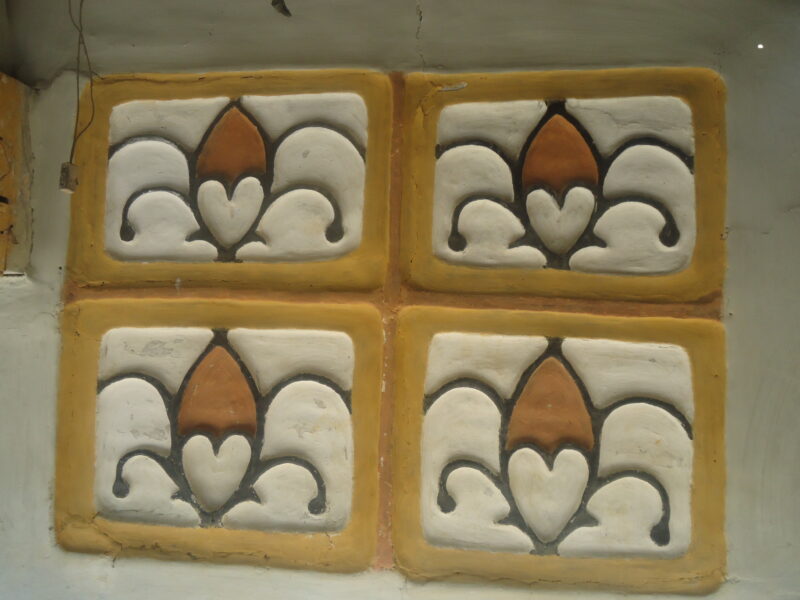
This beautiful mokha art from Eastern Nepal’s Sunsari District will be taken down soon due to road expansion. Photo by Sanjib Chaudhary. Used with permission.
In Nepal’s southern plains, village landscapes were once dominated by bamboo and mud-walled houses with thatched and tiled roofs. Particularly in Eastern Nepal, homes belonging to the Tharus were decorated with beautiful mokha art on mud walls. However, as the traditional mud houses in Nepal are being replaced by concrete houses, the famous art is on the verge of vanishing.
According to the National Population and Housing Census 2021, more than 50 percent of houses in Nepal have cemented walls, while around 30 percent of houses have mud-bonded brick or stone walls. Only around 11 percent of houses have bamboo walls, not to mention the 3.9 percent of houses with thatched roofs and 9.2 percent of houses with tiled roofs.
Generations of mokha art
In the eastern Nepali districts of Sunsari and Morang, the Tharus create intricate designs and patterns using a blend of clay mixed with rice bran, cow dung, straw and jute, known as mokha art.
The artists, mostly women, make a mixture of clay and jute, as shown in this YouTube video produced by Vision Nepal. Layers of clay are applied to the walls, forming various geometric and floral patterns, including depictions of birds such as peacocks and parrots. After the design dries, it is painted with natural colours, replaced by colours found in the market these days.

Mokha art, called ‘payar’, from a house in Eastern Nepal’s Saptari District. Photo by Sanjib Chaudhary. Used with permission.
Likewise, in the districts of Saptari, Siraha, and Udaypur, the artists use a mixture of clay, rice bran and cow dung and daub it on the bamboo walls together with straw. They apply layers of this mixture to create geometric and floral patterns, including peacocks, parrots and elephants. Once the design dries, it is painted with natural white clay before applying other natural colours — ochre and red clay, and black soot among others. This art, a form of mokha, is called ‘payar’.
Blogger Lex Limbu posted on X (formerly Twitter):
Beautiful mokha artwork on the walls of Saptariya Tharu family homes in Goigada. More: https://t.co/FMIFMGDedN #Tharu #Mokha #Art #SaptariyaTharu #PurviTharu #Nepal pic.twitter.com/4fkgveilvP
— lexlimbu (@lexlimbu) July 9, 2023
This art, along with its techniques, processes, motifs, and patterns, has been passed down from one generation to the next. Women typically inherit this knowledge from their mothers and grandmothers.
“It has been passed down from generation to generation within the rural family, usually — but by no means always — carried out by the women”, wrote Kurt W. Meyer and Pamela Deuel, who spent around four years touring nearly 300 Tharu villages. “There are no schools, no art colleges, no teachers who tell them what is ‘right’ and what is ‘wrong’ — it is for this reason that we call it ‘Art without Artists’”.
Art to decorate doors and windows
Mokha art and other forms of wall decorations are normally created during festivals and for special occasions like marriage.
“Mokha art is made on the right and left sides of the main door and around the windows,” writes Bishnu Prasad Chaudhary in his book Tharu Lok Kala (Tharu Folk Arts). “Adding jute and cotton to the clay minimizes cracking of the patterns.”
Likewise, adding milk to the colours before applying them to the designs ensures the colours don’t fade quickly. The female artists also decorate the pillars with these art motifs.
“A well-decorated house displaying mokha art is still known as a house having lucky women”, writes artist S.C. Suman. “There is prosperity in a house having mokha. According to popular belief among the Tharus, if there is no mokha in someone’s house, half a kilogram of rice is lost every day.”
Modernization killing the traditional art
Pramila Biswas of Labipur, Sunsari District in south-eastern Nepal, takes pride in showing the mokha art made by her mother-in-law, Jhalaiya Biswas. “Most of the houses in our village were decorated with mokha art,” Biswas said in an interview with Global Voices. “However, as the traditional houses are being replaced by concrete houses, we have only a few houses left with mokha art.”

Mokha art from Eastern Nepal’s Labipur Village in Sunsari District. Photo by Sanjib Chaudhary. Used with permission.
“As the municipality is expanding the road, the mokha art on my house walls will be taken down,” lamented Kishni Majhi from the same village.
Due to the cumbersome process of making mokha art and the painstaking effort required to maintain the wall art — many artists have to reapply the colours numerous times every year — many households are taking down the art and going for simple brick walls.
“We will keep maintaining the mokha art in our house,” said Hom Narayan Chaudhary from Duhabi, Sunsari. “However, we’re not sure whether our children would keep them intact.”
Not only do the houses in Labipur face these threats of extinction, but most of the Tharu traditional village houses in Nepal’s southern plains are awaiting the same fate. Without adequate measures taken to safeguard this exquisite Tharu folk art, it’s destined to disappear forever.










I played on this gambling website and won a considerable amount, but eventually, my mother fell sick, and I required to take out some funds from my account. Unfortunately, I experienced issues and couldn’t withdraw the funds. Tragically, my mother passed away due to this casino site. I request for your support in bringing attention to this website. Please help me to achieve justice, so that others do not experience the hardship I am going through today, and prevent them from shedding tears like mine. 😭😭😭�